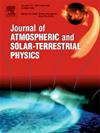Explanation of the data on densities of nitrogen oxides in the immediate neighborhood of ball lightning
IF 1.8
4区 地球科学
Q3 GEOCHEMISTRY & GEOPHYSICS
Journal of Atmospheric and Solar-Terrestrial Physics
Pub Date : 2025-01-10
DOI:10.1016/j.jastp.2025.106428
引用次数: 0
Abstract
The data on densities of nitrogen oxides in air sample, taken by M.T. Dmitriev in the immediate neighborhood of ball lightning, are explained for the first time within framework of ball lightning model based on the assumption that ball lightning has a core consisting of clouds of electrons and ions which oscillate with respect to each other and undergo the random motion disturbing the oscillatory one. According to the model, the nitrogen oxides in the air sample were produced mainly due to absorption of photons with energies of 100 eV to 10 keV, emitted by the ball lightning. The model also explains 75–80 s long lifetime of ball lightning observed by M.T. Dmitriev and yields that the ionizing radiation dose received by him was compatible with his survival.
球状闪电附近氮氧化物密度数据的解释
德米特里耶夫(M.T. Dmitriev)在球状闪电附近采集的空气中氮氧化物密度数据,首次在球状闪电模型的框架内进行了解释,该模型假定球状闪电有一个由电子和离子云组成的核心,这些电子和离子云相互振荡,并经历随机运动干扰振荡运动。根据该模型,空气样品中的氮氧化物主要是由于吸收球形闪电发射的能量在100 eV至10 keV之间的光子而产生的。该模型还解释了德米特里耶夫(M.T. Dmitriev)观测到的75-80秒的球状闪电的长寿命,并得出他所接受的电离辐射剂量与他的生存是相容的。
本文章由计算机程序翻译,如有差异,请以英文原文为准。
求助全文
约1分钟内获得全文
求助全文
来源期刊

Journal of Atmospheric and Solar-Terrestrial Physics
地学-地球化学与地球物理
CiteScore
4.10
自引率
5.30%
发文量
95
审稿时长
6 months
期刊介绍:
The Journal of Atmospheric and Solar-Terrestrial Physics (JASTP) is an international journal concerned with the inter-disciplinary science of the Earth''s atmospheric and space environment, especially the highly varied and highly variable physical phenomena that occur in this natural laboratory and the processes that couple them.
The journal covers the physical processes operating in the troposphere, stratosphere, mesosphere, thermosphere, ionosphere, magnetosphere, the Sun, interplanetary medium, and heliosphere. Phenomena occurring in other "spheres", solar influences on climate, and supporting laboratory measurements are also considered. The journal deals especially with the coupling between the different regions.
Solar flares, coronal mass ejections, and other energetic events on the Sun create interesting and important perturbations in the near-Earth space environment. The physics of such "space weather" is central to the Journal of Atmospheric and Solar-Terrestrial Physics and the journal welcomes papers that lead in the direction of a predictive understanding of the coupled system. Regarding the upper atmosphere, the subjects of aeronomy, geomagnetism and geoelectricity, auroral phenomena, radio wave propagation, and plasma instabilities, are examples within the broad field of solar-terrestrial physics which emphasise the energy exchange between the solar wind, the magnetospheric and ionospheric plasmas, and the neutral gas. In the lower atmosphere, topics covered range from mesoscale to global scale dynamics, to atmospheric electricity, lightning and its effects, and to anthropogenic changes.
 求助内容:
求助内容: 应助结果提醒方式:
应助结果提醒方式:


